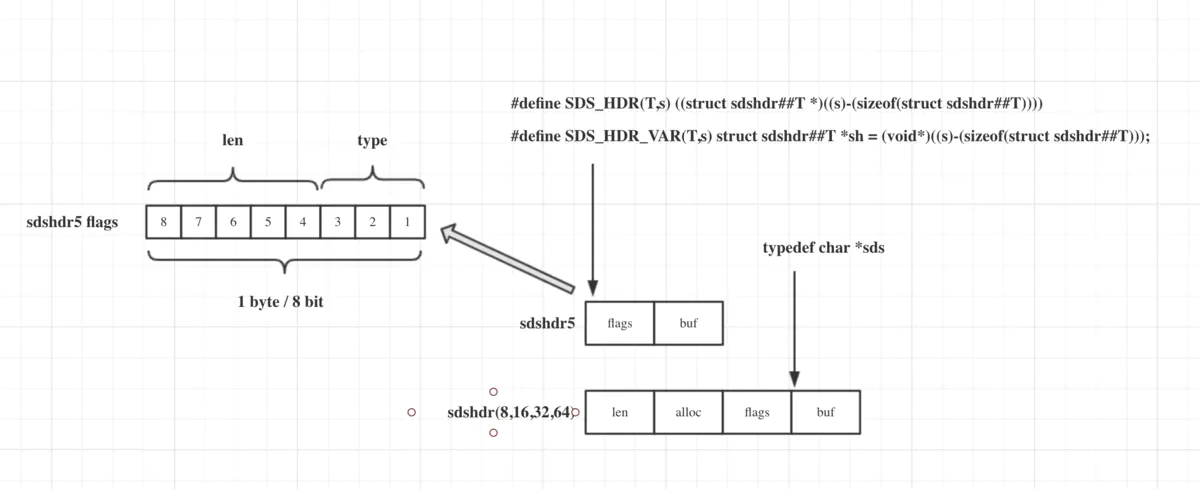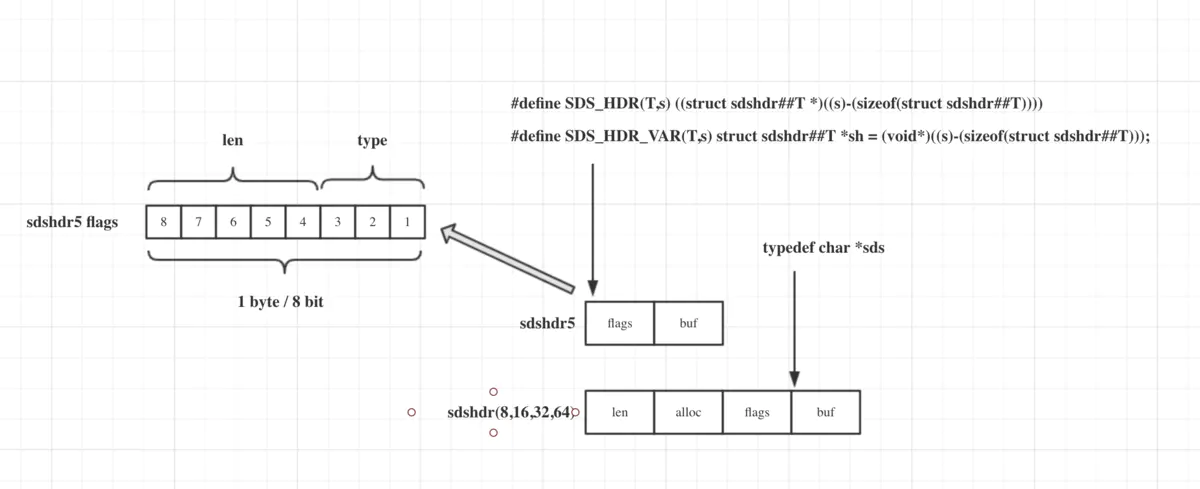为了节省内存空间,灵活处理不同长度范围的字符串,redis 定义了几种 sdshdr(X) 数据结构,对不同长度的字符串数据进行存储。
1. 数据结构

为了节省内存空间,灵活处理不同长度范围的字符串
- redis 定义了
sdshdr(X)几种数据结构,可以查看数据结构大小。 - 同时 struct 数据结构没有进行内存对齐。
typedef char *sds;
#define SDS_HDR(T,s) ((struct sdshdr##T *)((s)-(sizeof(struct sdshdr##T))))
#define SDS_HDR_VAR(T,s) struct sdshdr##T *sh = (void*)((s)-(sizeof(struct sdshdr##T)));
/* Note: sdshdr5 is never used, we just access the flags byte directly.
* However is here to document the layout of type 5 SDS strings. */
struct __attribute__ ((__packed__)) sdshdr5 {
// 当字符串很小时, `flags` 是一个8 个字节的组合字符,前 3 bit 是字符串类型,后面5bit是字符串长度。
unsigned char flags; /* 3 lsb of type, and 5 msb of string length */
char buf[];
};
struct __attribute__ ((__packed__)) sdshdr8 {
uint8_t len; /* used */
uint8_t alloc; /* excluding the header and null terminator */
unsigned char flags; /* 3 lsb of type, 5 unused bits */
char buf[];
};
struct __attribute__ ((__packed__)) sdshdr16 {
uint16_t len; /* used */
uint16_t alloc; /* excluding the header and null terminator */
unsigned char flags; /* 3 lsb of type, 5 unused bits */
char buf[];
};
struct __attribute__ ((__packed__)) sdshdr32 {
uint32_t len; /* used */
uint32_t alloc; /* excluding the header and null terminator */
unsigned char flags; /* 3 lsb of type, 5 unused bits */
char buf[];
};
struct __attribute__ ((__packed__)) sdshdr64 {
uint64_t len; /* used */
uint64_t alloc; /* excluding the header and null terminator */
unsigned char flags; /* 3 lsb of type, 5 unused bits */
char buf[];
};
| 成员 | 描述 |
|---|---|
| len | 当前已使用的内存空间长度 |
| alloc | 分配的内存空间长度 |
| flags | 数据结构类型或者(数据结构类型+字符串长度例如:sdshdr5) |
| buf | uf如果有数据,是以‘\0’结束的字符串。 |
1.1. sds 数据结构视图

制作图表方法可以用 processon,参考视频
- bilibili: 绘制 redis sds 数据结构内存空间视图
- youtube: Draw Redis SDS Struct Memmory Chart
1.2. 结构大小
可以通过函数 sdsReqType 知道,sds 数据结构,是根据数据长度范围去确定数据结构类型的。下面列出的数据结构的比较。
| 结构类型 | 大小 | 字符串长度 |
|---|---|---|
| sdshdr5 | 1 | 1« 5-1 |
| sdshdr8 | 3 | 1« 8-1 |
| sdshdr16 | 5 | 1« 16-1 |
| sdshdr32 | 9 | 1« 32-1 |
| sdshdr64 | 17 | 大于1« 32 |
static inline char sdsReqType(size_t string_size) {
if (string_size < 1<<5)
// 1 << 5 == 32,所以长度最大 31,二进制 11111,占 5 位。结合数据结构可以查看 flags 的组合,左移 5 位,存储字符串长度,右边3位存储字符串长度。
return SDS_TYPE_5;
if (string_size < 1<<8)
return SDS_TYPE_8;
if (string_size < 1<<16)
return SDS_TYPE_16;
#if (LONG_MAX == LLONG_MAX)
if (string_size < 1ll<<32)
return SDS_TYPE_32;
return SDS_TYPE_64;
#else
return SDS_TYPE_32;
#endif
}
- 例如 sdshdr32 数据结构, sizeof(sdshdr32) == 9 ,如果是字节对齐,应该 12 才对。
struct __attribute__((__packed__)) sdshdr32 {
uint32_t len; /* used */
uint32_t alloc; /* excluding the header and null terminator */
unsigned char flags; /* 3 lsb of type, 5 unused bits */
char buf[];
};
2. 核心接口
sds 主要的逻辑是对字符串内存管理。可以参考下面接口进行理解。
| 接口 | 描述 |
|---|---|
| sdsnew | 创建字符串对象 |
| sdsfree | 释放字符串结构对象 |
| sdsavail | 查询字符串对象空闲内存大小 |
| sdsnewlen | 根据字符串长度,分配合适的内存空间,设置数据结构的相关的成员数据 |
| sdsMakeRoomFor | 为对象分配增长的空间,增长小于1M,newlen*=2,否则newlen+=SDS_MAX_PREALLOC |
3. 工作流程
我们依旧可以用 gdb 对 sds 进行调试,熟悉它对工作流程。作者在 sds.c 文件就设置了测试宏SDS_TEST_MAIN,我们可以编译一个文件进行调试。
gcc -g -DSDS_TEST_MAIN sds.c zmalloc.c -o sds
调试方法,可以参考视频
- bilibili: Debug Redis sds with Gdb
- youtube: Debug Redis sds with Gdb
- 堆栈信息
#0 sdsnewlen (init=0x100006a71, initlen=3) at sds.c:99
#1 0x00000001000018a6 in sdsnew (init=0x100006a71 "foo") at sds.c:156
#2 0x0000000100004cb7 in sdsTest () at sds.c:1130
#3 0x0000000100006124 in main () at sds.c:1294
- sdsnewlen 根据字符串长度,用不同数据结构进行存储,每个数据结构有不同类型。
/* Create a new sds string starting from a null terminated C string. */
sds sdsnew(const char *init) {
size_t initlen = (init == NULL) ? 0 : strlen(init);
return sdsnewlen(init, initlen);
}
- 根据字符串长度,分配合适的内存空间,设置数据结构的相关的成员数据
/* Create a new sds string with the content specified by the 'init' pointer
* and 'initlen'.
* If NULL is used for 'init' the string is initialized with zero bytes.
* If SDS_NOINIT is used, the buffer is left uninitialized;
*
* The string is always null-termined (all the sds strings are, always) so
* even if you create an sds string with:
*
* mystring = sdsnewlen("abc",3);
*
* You can print the string with printf() as there is an implicit \0 at the
* end of the string. However the string is binary safe and can contain
* \0 characters in the middle, as the length is stored in the sds header. */
sds sdsnewlen(const void *init, size_t initlen) {
void *sh;
sds s;
char type = sdsReqType(initlen);
/* Empty strings are usually created in order to append. Use type 8
* since type 5 is not good at this. */
if (type == SDS_TYPE_5 && initlen == 0) type = SDS_TYPE_8;
int hdrlen = sdsHdrSize(type);
unsigned char *fp; /* flags pointer. */
// 申请数据结构内存。+ 1 是为了字符串的结束符 '\0'。
sh = s_malloc(hdrlen+initlen+1);
if (init==SDS_NOINIT)
init = NULL;
else if (!init)
memset(sh, 0, hdrlen+initlen+1);
if (sh == NULL) return NULL;
s = (char*)sh+hdrlen;
fp = ((unsigned char*)s)-1;
switch(type) {
case SDS_TYPE_5: {
// SDS_TYPE_BITS
*fp = type | (initlen << SDS_TYPE_BITS);
break;
}
case SDS_TYPE_8: {
SDS_HDR_VAR(8,s);
sh->len = initlen;
sh->alloc = initlen;
*fp = type;
break;
}
case SDS_TYPE_16: {
SDS_HDR_VAR(16,s);
sh->len = initlen;
sh->alloc = initlen;
*fp = type;
break;
}
case SDS_TYPE_32: {
SDS_HDR_VAR(32,s);
sh->len = initlen;
sh->alloc = initlen;
*fp = type;
break;
}
case SDS_TYPE_64: {
SDS_HDR_VAR(64,s);
sh->len = initlen;
sh->alloc = initlen;
*fp = type;
break;
}
}
if (initlen && init)
memcpy(s, init, initlen);
s[initlen] = '\0';
return s;
}
- 获取字符串长度
#define SDS_TYPE_5_LEN(f) ((f)>>SDS_TYPE_BITS)
static inline size_t sdslen(const sds s) {
unsigned char flags = s[-1];
switch(flags&SDS_TYPE_MASK) {
case SDS_TYPE_5:
// 一个字节高 5 位是长度,通过向右移动 3 位获得大小。
return SDS_TYPE_5_LEN(flags);
case SDS_TYPE_8:
return SDS_HDR(8,s)->len;
case SDS_TYPE_16:
return SDS_HDR(16,s)->len;
case SDS_TYPE_32:
return SDS_HDR(32,s)->len;
case SDS_TYPE_64:
return SDS_HDR(64,s)->len;
}
return 0;
}
- 释放内存,因为 sds struct 是一个连续的内存数据结构,根据 sds 指向的 buf,往回找 struct 的起始地址,进行释放。
看看
sdsnewlen是如何申请内存的。
/* Free an sds string. No operation is performed if 's' is NULL. */
void sdsfree(sds s) {
if (s == NULL) return;
s_free((char*)s-sdsHdrSize(s[-1]));
}
static inline int sdsHdrSize(char type) {
switch(type&SDS_TYPE_MASK) {
case SDS_TYPE_5:
return sizeof(struct sdshdr5);
case SDS_TYPE_8:
return sizeof(struct sdshdr8);
case SDS_TYPE_16:
return sizeof(struct sdshdr16);
case SDS_TYPE_32:
return sizeof(struct sdshdr32);
case SDS_TYPE_64:
return sizeof(struct sdshdr64);
}
return 0;
}
- 查询数据结构多少空闲内存空间
static inline size_t sdsavail(const sds s) {
unsigned char flags = s[-1];
switch(flags&SDS_TYPE_MASK) {
case SDS_TYPE_5: {
// 小于 32 长度的内存,都是直接申请的,没有空余内存。
return 0;
}
case SDS_TYPE_8: {
SDS_HDR_VAR(8,s);
return sh->alloc - sh->len;
}
case SDS_TYPE_16: {
SDS_HDR_VAR(16,s);
return sh->alloc - sh->len;
}
case SDS_TYPE_32: {
SDS_HDR_VAR(32,s);
return sh->alloc - sh->len;
}
case SDS_TYPE_64: {
SDS_HDR_VAR(64,s);
return sh->alloc - sh->len;
}
}
return 0;
}
- 追加内存
/* Append the specified null termianted C string to the sds string 's'.
*
* After the call, the passed sds string is no longer valid and all the
* references must be substituted with the new pointer returned by the call. */
sds sdscat(sds s, const char *t) {
return sdscatlen(s, t, strlen(t));
}
- redis sds 习惯先根据长度,分配合适的内存,再进行数据拷贝等操作。
/* Append the specified binary-safe string pointed by 't' of 'len' bytes to the
* end of the specified sds string 's'.
*
* After the call, the passed sds string is no longer valid and all the
* references must be substituted with the new pointer returned by the call. */
sds sdscatlen(sds s, const void *t, size_t len) {
size_t curlen = sdslen(s);
// 根据当前数据和追加的数据,分配合适长度的内存资源。
s = sdsMakeRoomFor(s,len);
if (s == NULL) return NULL;
memcpy(s+curlen, t, len);
sdssetlen(s, curlen+len);
s[curlen+len] = '\0';
return s;
}
- 根据增长的长度,为 sds 申请合适长度的空间。
/* Enlarge the free space at the end of the sds string so that the caller
* is sure that after calling this function can overwrite up to addlen
* bytes after the end of the string, plus one more byte for nul term.
*
* Note: this does not change the *length* of the sds string as returned
* by sdslen(), but only the free buffer space we have. */
sds sdsMakeRoomFor(sds s, size_t addlen) {
void *sh, *newsh;
// 获取剩余的内存
size_t avail = sdsavail(s);
size_t len, newlen;
char type, oldtype = s[-1] & SDS_TYPE_MASK;
int hdrlen;
/* Return ASAP if there is enough space left. */
if (avail >= addlen) return s;
len = sdslen(s);
sh = (char*)s-sdsHdrSize(oldtype);
newlen = (len+addlen);
// 小于 1 M 内存的翻倍增加,否则每次增加 1M
if (newlen < SDS_MAX_PREALLOC)
newlen *= 2;
else
newlen += SDS_MAX_PREALLOC;
type = sdsReqType(newlen);
// 如果小数据,遇到 cat 操作,类型升级到 SDS_TYPE_8,方便 cat 的后续操作。这里作者估计是根据很多场景结合的经验得出的结论。
/* Don't use type 5: the user is appending to the string and type 5 is
* not able to remember empty space, so sdsMakeRoomFor() must be called
* at every appending operation. */
if (type == SDS_TYPE_5) type = SDS_TYPE_8;
// 根据对应类型的对象申请相应的空间。
hdrlen = sdsHdrSize(type);
if (oldtype==type) {
newsh = s_realloc(sh, hdrlen+newlen+1);
if (newsh == NULL) return NULL;
s = (char*)newsh+hdrlen;
} else {
/* Since the header size changes, need to move the string forward,
* and can't use realloc */
newsh = s_malloc(hdrlen+newlen+1);
if (newsh == NULL) return NULL;
memcpy((char*)newsh+hdrlen, s, len+1);
s_free(sh);
s = (char*)newsh+hdrlen;
s[-1] = type;
sdssetlen(s, len);
}
sdssetalloc(s, newlen);
return s;
}
- 空数据结构
sdsempty(),一些不定长的字符串,例如sdscatprintf,格式化的字符串,经常性有很长的字符串。所以在sdsnewlen中给申请SDS_TYPE_8类型进行处理。
sds sdsnewlen(const void *init, size_t initlen) {
if (type == SDS_TYPE_5 && initlen == 0) type = SDS_TYPE_8;
}
- 去掉字符串头尾出现在字串的所有字符
/* Remove the part of the string from left and from right composed just of
* contiguous characters found in 'cset', that is a null terminted C string.
*
* After the call, the modified sds string is no longer valid and all the
* references must be substituted with the new pointer returned by the call.
*
* Example:
*
* s = sdsnew("AA...AA.a.aa.aHelloWorld :::");
* s = sdstrim(s,"Aa. :");
* printf("%s\n", s);
*
* Output will be just "HelloWorld".
*/
sds sdstrim(sds s, const char *cset) {
char *start, *end, *sp, *ep;
size_t len;
// 通过两次遍历,从头向尾,
sp = start = s;
ep = end = s+sdslen(s)-1;
while(sp <= end && strchr(cset, *sp)) sp++;
while(ep > sp && strchr(cset, *ep)) ep--;
len = (sp > ep) ? 0 : ((ep-sp)+1);
if (s != sp) memmove(s, sp, len);
s[len] = '\0';
sdssetlen(s,len);
return s;
}
- 两个 sds 字符串比较
取最短字符串的长度,该长度的两个字符串相比较,在这个条件基础上,对余下字符串进行比较。返回相应结果。
/* Compare two sds strings s1 and s2 with memcmp().
*
* Return value:
*
* positive if s1 > s2.
* negative if s1 < s2.
* 0 if s1 and s2 are exactly the same binary string.
*
* If two strings share exactly the same prefix, but one of the two has
* additional characters, the longer string is considered to be greater than
* the smaller one. */
int sdscmp(const sds s1, const sds s2) {
size_t l1, l2, minlen;
int cmp;
l1 = sdslen(s1);
l2 = sdslen(s2);
minlen = (l1 < l2) ? l1 : l2;
cmp = memcmp(s1, s2, minlen);
if (cmp == 0) return l1 > l2 ? 1 : (l1 < l2 ? -1 : 0);
return cmp;
}
4. 后记
源码走读系列,通过调试手段,走读源码,是自己流水账式的记录,从而理解了更多的实现细节。
Java 面试宝典是大明哥全力打造的 Java 精品面试题,它是一份靠谱、强大、详细、经典的 Java 后端面试宝典。它不仅仅只是一道道面试题,而是一套完整的 Java 知识体系,一套你 Java 知识点的扫盲贴。
它的内容包括:
- 大厂真题:Java 面试宝典里面的题目都是最近几年的高频的大厂面试真题。
- 原创内容:Java 面试宝典内容全部都是大明哥原创,内容全面且通俗易懂,回答部分可以直接作为面试回答内容。
- 持续更新:一次购买,永久有效。大明哥会持续更新 3+ 年,累计更新 1000+,宝典会不断迭代更新,保证最新、最全面。
- 覆盖全面:本宝典累计更新 1000+,从 Java 入门到 Java 架构的高频面试题,实现 360° 全覆盖。
- 不止面试:内容包含面试题解析、内容详解、知识扩展,它不仅仅只是一份面试题,更是一套完整的 Java 知识体系。
- 宝典详情:https://www.yuque.com/chenssy/sike-java/xvlo920axlp7sf4k
- 宝典总览:https://www.yuque.com/chenssy/sike-java/yogsehzntzgp4ly1
- 宝典进展:https://www.yuque.com/chenssy/sike-java/en9ned7loo47z5aw
目前 Java 面试宝典累计更新 400+ 道,总字数 42w+。大明哥还在持续更新中,下图是大明哥在 2024-12 月份的更新情况:

想了解详情的小伙伴,扫描下面二维码加大明哥微信【daming091】咨询

同时,大明哥也整理一套目前市面最常见的热点面试题。微信搜[大明哥聊 Java]或扫描下方二维码关注大明哥的原创公众号[大明哥聊 Java] ,回复【面试题】 即可免费领取。

